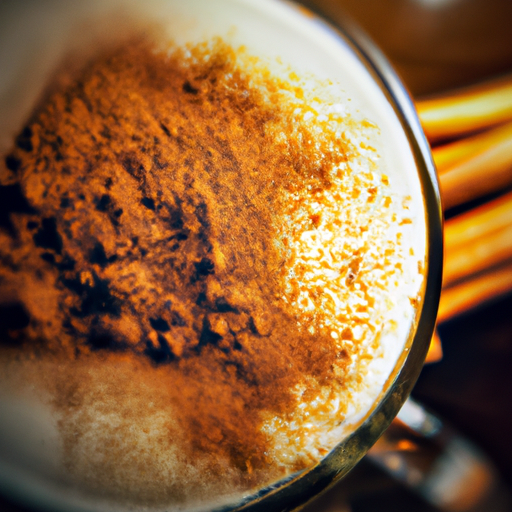Turmeric milk, also known as golden milk, has been a tradition in my family for generations. As a child in India, my grandmother would prepare it for me whenever I was feeling unwell. This comforting beverage consistently brought relief and healing to both my body and mind.
As I got older, I became curious about the science behind this ancient remedy and discovered that turmeric milk has a host of nutritional and medicinal benefits. Turmeric milk is a mixture of turmeric powder and milk, often sweetened with honey or sugar. The bright yellow color of the drink comes from the active ingredient in turmeric called curcumin, which has potent anti-inflammatory and antioxidant properties.
In this article, we will explore the history and cultural significance of turmeric milk, its nutritional benefits, how to make it, and its traditional uses in medicine. We will also dive into the scientific research on the health benefits of turmeric, precautions and potential side effects, and its role in Ayurvedic medicine.
So, grab a cup of turmeric milk and let’s explore this ancient elixir together.
Key Takeaways
- Turmeric milk is a traditional remedy in India for various ailments, made by mixing turmeric powder and milk, often sweetened with honey or sugar.
- The active ingredient in turmeric called curcumin has potent anti-inflammatory and antioxidant properties, and has numerous health benefits, including improving brain function, reducing joint pain, and boosting the immune system.
- Other spices such as cinnamon and ginger can be added for enhanced flavor and health benefits, and vegan and dairy-free options include almond milk, coconut milk, and oat milk.
- Turmeric milk is a warm and comforting beverage that can be consumed before bed to aid in relaxation and promote a restful night’s sleep, but should not be used as a replacement for medical treatment.
History and cultural significance of turmeric milk
You’re probably wondering why turmeric milk has been cherished for centuries by cultures across the globe, but once you learn about its rich history and cultural significance, you’ll understand why it’s more than just a trendy drink.
Turmeric milk, also known as golden milk, has been used in traditional medicine practices for thousands of years in Ayurvedic and Chinese medicine. Its deep, vibrant yellow color symbolizes purity, auspiciousness, and spirituality in Hinduism, where it is often used in religious rituals.
Turmeric milk’s cultural significance extends beyond its use in religious ceremonies. In India, it is a common home remedy for a variety of ailments, from colds and coughs to sore throats and digestive issues. It is also used as a sleep aid, as the warm, soothing drink can help calm the mind and promote relaxation.
In other cultures, such as Morocco and Indonesia, turmeric milk is a traditional wedding drink, symbolizing fertility and prosperity. Its rich history and cultural significance make turmeric milk an important part of many people’s lives around the world.
Now, let’s explore the nutritional benefits of this beloved drink.
Nutritional benefits of turmeric milk
Although it may seem like a trendy health drink, turmeric milk has been used for centuries in Ayurvedic medicine to combat inflammation and aid in digestion. This golden elixir, also known as ‘golden milk,’ is made by mixing turmeric with milk and other spices such as ginger and cinnamon.
The benefits of consuming turmeric milk for overall health and wellness are numerous, with some of the most notable being its ability to improve brain function, reduce joint pain, and boost the immune system. Turmeric milk is not only beneficial for internal health, but it also has benefits for skin health.
The anti-inflammatory properties of turmeric can help reduce acne and other skin conditions, while also providing a natural glow to the skin. Additionally, the antioxidants in turmeric can help protect the skin from damage caused by free radicals and UV rays. By incorporating turmeric milk into your daily routine, you can reap these benefits and improve your overall health and well-being.
In the next section, I’ll explain how to make turmeric milk at home.
How to make turmeric milk
I’m going to show you how to make delicious and healthy turmeric milk at home. To prepare turmeric milk, you’ll need a few simple ingredients such as milk, turmeric powder, black pepper, and sweetener of your choice.
The preparation method involves heating the milk with turmeric and other ingredients and then letting it simmer for a few minutes.
Ingredients
If you’re looking for a cozy and comforting drink, turmeric milk is a perfect option because it only requires a few simple ingredients. The main ingredient is turmeric, a spice that has been used for centuries in Ayurvedic and Chinese medicine for its anti-inflammatory and antioxidant properties. Other ingredients include milk, sweetener, and optional spices such as cinnamon and ginger.
When making turmeric milk, it’s important to use fresh turmeric whenever possible. Fresh turmeric has a more vibrant color and stronger flavor than dried turmeric, and contains higher levels of the active compound curcumin. Curcumin has been shown to have numerous health benefits, including reducing inflammation and improving brain function. Below is a table showing some variations of turmeric milk and the benefits of using fresh turmeric:
| Variation | Benefits of using fresh turmeric |
|---|---|
| Traditional Turmeric Milk | More vibrant color and stronger flavor |
| Golden Milk (with ginger and cinnamon) | Enhanced anti-inflammatory and antioxidant properties |
| Vegan Turmeric Milk (with non-dairy milk) | Reduced inflammation and improved digestion |
To make the perfect turmeric milk, it’s important to use fresh turmeric and other high-quality ingredients. With just a few simple steps, you can make a warm and comforting drink that not only tastes great but also provides numerous health benefits.
Preparation method
To prepare this comforting drink, start by heating up your choice of dairy or non-dairy liquid until it’s warm and steamy. Did you know that the ideal temperature for heating milk is between 150-155°F?
Once heated, whisk in some ground turmeric, black pepper, cinnamon, and a sweetener of your choice, such as honey or maple syrup. The black pepper is essential as it increases the bioavailability of turmeric, allowing your body to absorb it better.
If you prefer an alternative modification, you can add a pinch of ginger or cardamom to the mix. These spices not only enhance the taste but also offer additional health benefits such as reducing inflammation and aiding digestion.
There are also various flavor variations you can try, such as adding vanilla extract or using coconut milk instead of regular milk. These variations can add a unique twist to your turmeric milk recipe and help you find the perfect flavor that suits your taste buds.
Moving on to the next section about variations of turmeric milk, let’s explore some more creative ways to enjoy this golden elixir.
Variations of turmeric milk
I love experimenting with different variations of turmeric milk to find new and exciting flavors. One way to switch things up is by adding other spices like cinnamon, ginger, or cardamom.
For those who are vegan or dairy-free, there are also plenty of options available using non-dairy milk such as almond or coconut milk.
Adding other spices
Turmeric milk is a warm and comforting beverage that can be enhanced with other spices. You can add cinnamon, ginger, and black pepper to create a flavorful and aromatic drink. The pairing possibilities are endless, and you can combine these spices in various ways to create different taste combinations.
Here are some ideas for spicing up your turmeric milk:
- Cinnamon and nutmeg for a sweet and spicy flavor
- Ginger and cardamom for an earthy and tangy taste
- Black pepper and honey for a subtle kick and sweetness
- Vanilla and cloves for a warm and cozy drink
By adding these spices, you can elevate the taste of your turmeric milk and create a unique and delicious beverage. Now, let’s move on to exploring vegan and dairy-free options for those who cannot have milk.
Vegan and dairy-free options
If you’re dairy-free or vegan, you’ll be happy to know that there are plenty of options available for you to enjoy this comforting beverage. Did you know that approximately 65% of the world’s population is lactose intolerant? So, it’s great to have plant-based alternatives like almond milk, coconut milk, or oat milk to make turmeric milk. Not only are these vegan alternatives tasty, but they also come with health benefits. Almond milk is low in calories and high in vitamin E, coconut milk is packed with lauric acid that boosts the immune system, and oat milk is a rich source of fiber that helps reduce cholesterol levels.
Here’s a quick comparison of the nutritional value of these vegan alternatives:
| Nutrient | Almond Milk | Coconut Milk | Oat Milk |
|---|---|---|---|
| Calories (per cup) | 30 | 552 | 120 |
| Fat (grams) | 2.5 | 57.2 | 5 |
| Protein (grams) | 1 | 5.5 | 3 |
| Fiber (grams) | 1 | 5.2 | 2 |
| Calcium (milligrams) | 450 | 38 | 350 |
As you can see, the calorie and fat content of these plant-based alternatives varies greatly. Therefore, it’s important to choose one that best suits your dietary needs. With these vegan options, you can enjoy the goodness of turmeric milk without any health concerns. Moving on to the next section, we’ll explore the traditional uses of turmeric in medicine.
Traditional uses of turmeric in medicine
Historically, turmeric has been used for its medicinal properties in cultures across the world. In Ayurvedic remedies, turmeric was used to treat a variety of ailments, ranging from digestive issues to skin problems. It was also commonly used as a pain reliever and anti-inflammatory agent.
Aside from Ayurvedic remedies, turmeric was also used in Chinese medicine to treat conditions such as menstrual irregularities and liver problems. Meanwhile, in traditional Indian medicine, it was used as a blood purifier and to treat respiratory illnesses. These traditional uses of turmeric in medicine have been passed down from generation to generation and are still being practiced today.
Turmeric’s use in medicine has been well-documented over the years, and with the advancements in scientific research, we’re discovering more about its health benefits.
Scientific research on the health benefits of turmeric
With the advancements in scientific research, we now have a better understanding of the numerous health benefits that turmeric can provide. Studies have shown that turmeric contains a powerful anti-inflammatory compound called curcumin, which can help reduce inflammation in the body and alleviate symptoms associated with conditions such as arthritis, asthma, and heart disease.
In addition to its anti-inflammatory properties, turmeric has also been found to have antioxidant and antimicrobial effects. These properties make turmeric a popular ingredient in many health supplements and natural remedies.
However, it’s important to note that while turmeric supplements may be beneficial for some individuals, they should be used with caution and under the guidance of a healthcare professional. This will help to ensure that any potential side effects or interactions with other medications are closely monitored.
Precautions and potential side effects
Be careful when taking supplements containing curcumin, as too much of it can cause extreme nausea and even vomiting, which feels like being hit by a ton of bricks. It’s also important to note that turmeric may interact with certain medications, such as blood thinners, and may worsen gallbladder problems. To avoid any potential negative effects, it’s best to consult with a healthcare provider before adding turmeric or curcumin supplements to your diet.
When consuming turmeric milk, it’s generally considered safe, but it’s important to be aware of any potential allergic reactions. Additionally, excessive consumption of turmeric milk may lead to gastrointestinal issues such as bloating, diarrhea, and stomach cramps. It’s recommended to consume turmeric milk in moderation and to listen to your body’s reactions. As with any dietary supplement, it’s important to be mindful and cautious in order to reap the potential benefits of turmeric milk without experiencing any negative side effects.
Moving on to the next section, turmeric milk has been used for centuries in Ayurvedic medicine.
Turmeric milk and Ayurveda
In Ayurvedic medicine, turmeric milk has been valued for centuries due to its healing properties. This golden-hued beverage aligns with Ayurvedic principles and is believed to balance the body’s doshas or energies. The combination of turmeric and milk provides a nourishing and grounding drink that can help with inflammation, digestion, and overall immune system support.
Turmeric milk is often consumed before bed to aid in relaxation and promote a restful night’s sleep. Its anti-inflammatory properties may also help with joint pain and stiffness. However, it’s important to note that while turmeric milk can have numerous benefits, it shouldn’t be used as a replacement for medical treatment.
In the next section, we’ll explore other uses for turmeric.
Other uses for turmeric
There are many ways to incorporate turmeric into your diet, such as adding it to soups, stews, and curries. Interestingly, a study found that consuming turmeric alongside black pepper can increase the absorption of curcumin, the active ingredient in turmeric, by up to 2,000%. This makes it an even more valuable addition to your meals, as it can provide numerous health benefits such as reducing inflammation, improving brain function, and aiding in digestion.
But turmeric isn’t only useful in the kitchen – it also has benefits for your skin. Turmeric is known for its anti-inflammatory properties, which can help reduce redness and irritation. It’s also high in antioxidants, which can help protect your skin from damage caused by free radicals.
You can create a turmeric face mask by mixing turmeric with yogurt and honey, or use a turmeric-infused skincare product to reap the benefits. Whether you use turmeric in cooking or in your skincare routine, it’s clear that this spice is a versatile and valuable addition to any healthy lifestyle.
Frequently Asked Questions
What are some common alternative names for turmeric milk?
As someone who enjoys drinking Golden milk or haldi doodh, I can tell you that these are common alternative names for turmeric milk. While it has a rich cultural history and numerous health benefits, drinking it regularly may also have drawbacks.
Can turmeric milk be used as a substitute for coffee or tea?
As a coffee lover, I was hesitant to try turmeric milk as a substitute. But the benefits of turmeric milk, like reducing inflammation and boosting immunity, made me curious. I found delicious recipes for turmeric milk lattes and now enjoy them regularly.
Is turmeric milk safe for pregnant or breastfeeding women?
As a pregnant or breastfeeding woman, it’s important to check with your healthcare provider before consuming turmeric milk. While turmeric is generally considered safe in small amounts, it’s best to err on the side of caution and seek guidance from a professional.
Can turmeric milk help with skin conditions such as acne or eczema?
Turmeric milk benefits skin conditions like acne and eczema. To make it at home, mix turmeric powder with warm milk. The anti-inflammatory properties of turmeric can reduce redness and inflammation, promoting healthy skin.
Are there any specific types of turmeric that are better for making turmeric milk?
Fresh turmeric is ideal for making turmeric milk, and different varieties of turmeric vary in flavor and potency. Using fresh turmeric ensures maximum health benefits, while adding a unique taste to the milk.
Conclusion
In conclusion, turmeric milk is a delicious and nutritious beverage that has been enjoyed for centuries. As I sipped on a warm cup of turmeric milk, I couldn’t help but think of the saying, "an ounce of prevention is worth a pound of cure."This metaphor perfectly illustrates the benefits of incorporating turmeric milk into our daily routine.
One study found that consuming turmeric milk regularly can help reduce inflammation, which is a common factor in many chronic diseases. By drinking turmeric milk, we’re taking a proactive step towards preventing these illnesses before they even occur. It’s like investing in our health for the long term, rather than just treating the symptoms of a problem after it arises.
Overall, turmeric milk is a great addition to any diet. Not only is it delicious and easy to make, but it also provides numerous health benefits that can help us lead longer, healthier lives. So, the next time you’re looking for a warm and comforting drink, give turmeric milk a try – your body will thank you!










